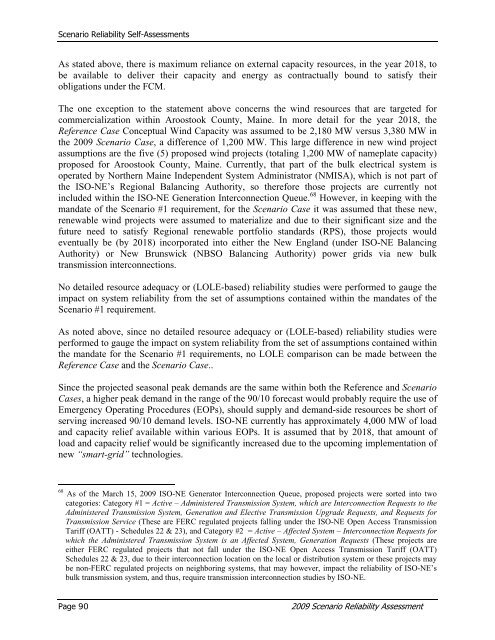2009 Scenario Reliability Assessment - NERC
2009 Scenario Reliability Assessment - NERC
2009 Scenario Reliability Assessment - NERC
- No tags were found...
You also want an ePaper? Increase the reach of your titles
YUMPU automatically turns print PDFs into web optimized ePapers that Google loves.
<strong>Scenario</strong> <strong>Reliability</strong> Self-<strong>Assessment</strong>sAs stated above, there is maximum reliance on external capacity resources, in the year 2018, tobe available to deliver their capacity and energy as contractually bound to satisfy theirobligations under the FCM.The one exception to the statement above concerns the wind resources that are targeted forcommercialization within Aroostook County, Maine. In more detail for the year 2018, theReference Case Conceptual Wind Capacity was assumed to be 2,180 MW versus 3,380 MW inthe <strong>2009</strong> <strong>Scenario</strong> Case, a difference of 1,200 MW. This large difference in new wind projectassumptions are the five (5) proposed wind projects (totaling 1,200 MW of nameplate capacity)proposed for Aroostook County, Maine. Currently, that part of the bulk electrical system isoperated by Northern Maine Independent System Administrator (NMISA), which is not part ofthe ISO-NE’s Regional Balancing Authority, so therefore those projects are currently notincluded within the ISO-NE Generation Interconnection Queue. 68 However, in keeping with themandate of the <strong>Scenario</strong> #1 requirement, for the <strong>Scenario</strong> Case it was assumed that these new,renewable wind projects were assumed to materialize and due to their significant size and thefuture need to satisfy Regional renewable portfolio standards (RPS), those projects wouldeventually be (by 2018) incorporated into either the New England (under ISO-NE BalancingAuthority) or New Brunswick (NBSO Balancing Authority) power grids via new bulktransmission interconnections.No detailed resource adequacy or (LOLE-based) reliability studies were performed to gauge theimpact on system reliability from the set of assumptions contained within the mandates of the<strong>Scenario</strong> #1 requirement.As noted above, since no detailed resource adequacy or (LOLE-based) reliability studies wereperformed to gauge the impact on system reliability from the set of assumptions contained withinthe mandate for the <strong>Scenario</strong> #1 requirements, no LOLE comparison can be made between theReference Case and the <strong>Scenario</strong> Case..Since the projected seasonal peak demands are the same within both the Reference and <strong>Scenario</strong>Cases, a higher peak demand in the range of the 90/10 forecast would probably require the use ofEmergency Operating Procedures (EOPs), should supply and demand-side resources be short ofserving increased 90/10 demand levels. ISO-NE currently has approximately 4,000 MW of loadand capacity relief available within various EOPs. It is assumed that by 2018, that amount ofload and capacity relief would be significantly increased due to the upcoming implementation ofnew “smart-grid” technologies.68 As of the March 15, <strong>2009</strong> ISO-NE Generator Interconnection Queue, proposed projects were sorted into twocategories: Category #1 = Active – Administered Transmission System, which are Interconnection Requests to theAdministered Transmission System, Generation and Elective Transmission Upgrade Requests, and Requests forTransmission Service (These are FERC regulated projects falling under the ISO-NE Open Access TransmissionTariff (OATT) - Schedules 22 & 23), and Category #2 = Active – Affected System – Interconnection Requests forwhich the Administered Transmission System is an Affected System, Generation Requests (These projects areeither FERC regulated projects that not fall under the ISO-NE Open Access Transmission Tariff (OATT)Schedules 22 & 23, due to their interconnection location on the local or distribution system or these projects maybe non-FERC regulated projects on neighboring systems, that may however, impact the reliability of ISO-NE’sbulk transmission system, and thus, require transmission interconnection studies by ISO-NE.Page 90<strong>2009</strong> <strong>Scenario</strong> <strong>Reliability</strong> <strong>Assessment</strong>
















